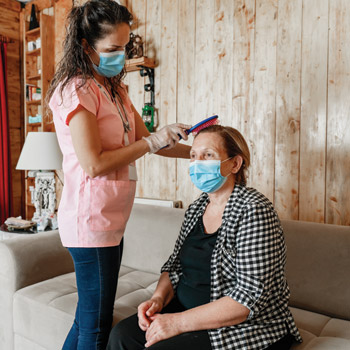Treating the lingering effects of COVID-19
An expert offered tips on helping patients who catch the novel coronavirus and then can't shake the symptoms.
The pandemic has been a long haul for everyone, but perhaps most intensely for those patients who catch the virus and then can't shake the symptoms.
There's still very little information about this problem, which is not yet precisely defined or even named, according to ACP Member Aluko A. Hope, MD, MSCE. But as co-director of the COVID-19 Recovery Clinic for Montefiore Medical Center in the Bronx, N.Y., he's more familiar than most clinicians with what he called “postacute COVID-19.”
As the existence of the clinic indicates, physicians have found ways to help these patients despite the many uncertainties about what causes their symptoms. Dr. Hope, who is an associate professor of pulmonary and critical care medicine at Albert Einstein College of Medicine, offered his perspective on this growing challenge during CHEST 2020, held virtually in October.
Data after COVID-19

Patients have taken a lead role in trying to figure out the post-COVID problem, organizing themselves by a variety of methods, including social media and apps. “There's a Facebook group already that's called itself ‘COVID long haulers,’” said Dr. Hope. “I think some of the more interesting research is coming from patient-led efforts where they're studying symptoms using phone apps.”
As an example, he cited a preprint publication posted on medRxiv on Oct. 21 that gathered self-reported data from more than 4,000 patients who had COVID-19 in the United Kingdom. “For one in 10 patients, the symptoms lasted for greater than three weeks, and for one in 20, you can have persistent symptoms for sometimes eight weeks,” Dr. Hope reported.
Other evidence comes from a study published by MMWR in July, which surveyed 292 outpatients across the U.S. a median of 60 days after they tested positive for SARS-CoV-2.
“Fourteen to 21 days out, 35% of these patients—who were at least not initially hospitalized when they were first diagnosed—were not back to their usual state of health,” he said.
In that study, patients reported cough, fatigue, and shortness of breath as three of the more common symptoms, but Dr. Hope has heard of many others. “Tachycardia while standing or walking up stairs can be just really drastic—150, 160 [beats/min], night sweats. … We've had patients report peripheral vasoconstriction, or what's called COVID toes. … The brain fog I think is particularly troublesome—the difficulty concentrating, difficulty remembering words.”
This appears to occur more commonly among women than men, he reported, and the MMWR study found that risk factors for persistent symptoms included older age and having more than one comorbidity.
An unusual aspect of the problem is that recovery is not linear. “For the patients who seem to have this postacute COVID, they do seem to report a relapsing remitting course, actually, so it can get better and then it can get worse again,” said Dr. Hope.
The severity of illness also does not appear to determine the likelihood of aftereffects. “In fact, some of the literature suggests the opposite, that it's the milder patients that tend to have the prolonged symptoms,” Dr. Hope reported. That finding might be biased by patients who were less sick participating more actively in research and will require more study, he noted.
Why any of this happens at all is also still unknown.
“It's sort of a cacophony of multiple different potential explanations,” Dr. Hope said. “There are your immunologists doing hypotheses about persistent immune activation or dysregulation. There's the potential that the virus is still being replicated in some patients. There are some subsets of patients with residual organ damage from that acute infection. And then there's always people that had comorbidities that were sort of mild, and then they get worse after the infection.”
In addition, patients whose COVID-19 required an ICU stay may be dealing with post-intensive care syndrome, the new or worsening impairments that can plague survivors of critical illness and have been the focus of research since long before the pandemic started. Those symptoms can include anxiety and depression, cognitive and attention impairments, protracted weakness, and shortness of breath.
There's already evidence of the long-term impacts of post-intensive care syndrome on patients' functioning, such as a study Dr. Hope cited from the October 2019 Annals of the American Thoracic Society. “This recent meta-analysis that looked at 22 studies with thousands of patients suggested that even at 12 months, about 56% of our patients are returning to work, which means that a lot of our patients in the ICU don't return to work,” he said. “I think it's mostly driven by symptoms like the fatigue, the psychiatric distress, the anxiety, the depression.”
Fatigue has also been shown to be common in prepandemic survivors of acute respiratory distress syndrome, for example, in a study published in the September 2020 CHEST. “Again, the prevalence is quite high, up to 66%, and it is also more severe in women,” he cited.
Multiple aspects of the pandemic may have exacerbated the usual effects of an ICU stay. “There's a lot of differences in our team composition,” Dr. Hope said. “We're using a lot more sedation, and as a result, there may be more time on life support. The PPE shortage, and also just the general anxiety of the pandemic era, really does decrease the physical presence of the nurses, physicians, and other clinicians. And the family visitation is a constant challenge.” Shortages of drugs such as fentanyl have also changed treatment protocols.
Taking action
The strategies for reducing the risk of these aftereffects while patients are in the ICU remain the same as always. “Still the ABCDEF bundle,” said Dr. Hope, referring to Assess, prevent, and manage pain; Both spontaneous awakening trials and spontaneous breathing trials; Choice of analgesia and sedation; Delirium: assess, prevent, and manage; Early mobility and Exercise; and Family engagement.
Clinicians do need to think carefully about how to complete these steps within pandemic constraints, Dr. Hope noted. And they might also want to consider providing specialized care for patients after hospitalization for COVID-19, because even the most basic aspects of care transitions are complicated by this new disease.
“Medication reconciliation might seem like a very benign thing, and yet, there's a lot of questions,” he said. “How long do we leave the anticoagulation on? Do we check the D-dimers?”
His COVID-19 recovery clinic also assesses patients' physical, mental, and emotional health. “We can then appropriately manage these patients and help them accommodate some of the impairments that they might be struggling with. We coordinate with physical therapy, occupational therapy, and speech therapy. We might send a subspecialty referral based on patients coming in with after-effects of the virus in various organ systems,” said Dr. Hope.
Patient education is an important component of aftercare, he explained, offering an example in his response to a question about treatment of cyclic dyspnea. “I tend to set expectations that there is going to be this possibility of a relapsing and remitting course,” he said. “Just having a plan for how to manage the symptoms, when they have these ups and downs, I think is probably more important than repeating the diagnostic workup.”
Clinics should also address the social effects of COVID-19. “We do assess a lot of the different social determinants of health because we find that in the pandemic era, a lot of the patients who survived COVID were socially very marginalized,” he said, citing the example of a woman who was unable to move back into her home after hospitalization because she lived with her 80-year-old mother.
“So she was essentially left homeless and had to go to the shelter after COVID, where she was living with her three children,” Dr. Hope said.
For problems like this, the clinic connects patients with community resources. It also provides emotional support. “I think it's also important because of the fact that these patients—when they come in with the long-haul symptoms particularly—often have gone to multiple providers,” he said. “They've been told that it's just in your head, or they've really been minimized.”
Clinicians can potentially alleviate this COVID-19 problem even if they can't cure the long-term effects. “We really try to be an effective witness to talk about what's contributing to the symptoms, sort of treat the symptoms when we can, but also acknowledge that we've seen this before, and that can be something that patients find very valuable,” said Dr. Hope.
For additional support, patients are connected with their peers. “Peer support is particularly relevant for the COVID survivors, and I think it's particularly something that should be tried in some of the centers,” he said.
COVID-19 peer support at Montefiore was started by a patient of Dr. Hope's who was a health educator before she caught the virus. “So she became our peer mentor, with a social worker who has an interest in this area. And the two of them co-facilitate our peer support group,” he said.
To help other facilities launch similar programs, either from the ground up or by modifying existing peer support groups, he and colleagues have developed quick-start guides. “We list some easy steps,” Dr. Hope said, encouraging physicians to visit the webinars page of the Critical and Acute Illness Recovery Organization (CAIRO)'s website. “Learn from all of the sites internationally that have been doing this work for many, many years.”
CAIRO is an international collaborative that generally works on improving well-being after critical illness but has also specifically been promoting post-ICU clinics and peer support programs, he noted.
These efforts to improve aftercare hold potential benefits not just for patients, but also clinicians. “The really important point is that by studying patients who are recovering from COVID, and recovering from critical illness, it can give us new targets for quality improvement of our care. It can give us new survivorship roles. It can really improve our burnout and understanding of our own patients' experiences,” Dr. Hope said.



